Nokia 2010 Annual Report Download - page 263
Download and view the complete annual report
Please find page 263 of the 2010 Nokia annual report below. You can navigate through the pages in the report by either clicking on the pages listed below, or by using the keyword search tool below to find specific information within the annual report.-
 1
1 -
 2
2 -
 3
3 -
 4
4 -
 5
5 -
 6
6 -
 7
7 -
 8
8 -
 9
9 -
 10
10 -
 11
11 -
 12
12 -
 13
13 -
 14
14 -
 15
15 -
 16
16 -
 17
17 -
 18
18 -
 19
19 -
 20
20 -
 21
21 -
 22
22 -
 23
23 -
 24
24 -
 25
25 -
 26
26 -
 27
27 -
 28
28 -
 29
29 -
 30
30 -
 31
31 -
 32
32 -
 33
33 -
 34
34 -
 35
35 -
 36
36 -
 37
37 -
 38
38 -
 39
39 -
 40
40 -
 41
41 -
 42
42 -
 43
43 -
 44
44 -
 45
45 -
 46
46 -
 47
47 -
 48
48 -
 49
49 -
 50
50 -
 51
51 -
 52
52 -
 53
53 -
 54
54 -
 55
55 -
 56
56 -
 57
57 -
 58
58 -
 59
59 -
 60
60 -
 61
61 -
 62
62 -
 63
63 -
 64
64 -
 65
65 -
 66
66 -
 67
67 -
 68
68 -
 69
69 -
 70
70 -
 71
71 -
 72
72 -
 73
73 -
 74
74 -
 75
75 -
 76
76 -
 77
77 -
 78
78 -
 79
79 -
 80
80 -
 81
81 -
 82
82 -
 83
83 -
 84
84 -
 85
85 -
 86
86 -
 87
87 -
 88
88 -
 89
89 -
 90
90 -
 91
91 -
 92
92 -
 93
93 -
 94
94 -
 95
95 -
 96
96 -
 97
97 -
 98
98 -
 99
99 -
 100
100 -
 101
101 -
 102
102 -
 103
103 -
 104
104 -
 105
105 -
 106
106 -
 107
107 -
 108
108 -
 109
109 -
 110
110 -
 111
111 -
 112
112 -
 113
113 -
 114
114 -
 115
115 -
 116
116 -
 117
117 -
 118
118 -
 119
119 -
 120
120 -
 121
121 -
 122
122 -
 123
123 -
 124
124 -
 125
125 -
 126
126 -
 127
127 -
 128
128 -
 129
129 -
 130
130 -
 131
131 -
 132
132 -
 133
133 -
 134
134 -
 135
135 -
 136
136 -
 137
137 -
 138
138 -
 139
139 -
 140
140 -
 141
141 -
 142
142 -
 143
143 -
 144
144 -
 145
145 -
 146
146 -
 147
147 -
 148
148 -
 149
149 -
 150
150 -
 151
151 -
 152
152 -
 153
153 -
 154
154 -
 155
155 -
 156
156 -
 157
157 -
 158
158 -
 159
159 -
 160
160 -
 161
161 -
 162
162 -
 163
163 -
 164
164 -
 165
165 -
 166
166 -
 167
167 -
 168
168 -
 169
169 -
 170
170 -
 171
171 -
 172
172 -
 173
173 -
 174
174 -
 175
175 -
 176
176 -
 177
177 -
 178
178 -
 179
179 -
 180
180 -
 181
181 -
 182
182 -
 183
183 -
 184
184 -
 185
185 -
 186
186 -
 187
187 -
 188
188 -
 189
189 -
 190
190 -
 191
191 -
 192
192 -
 193
193 -
 194
194 -
 195
195 -
 196
196 -
 197
197 -
 198
198 -
 199
199 -
 200
200 -
 201
201 -
 202
202 -
 203
203 -
 204
204 -
 205
205 -
 206
206 -
 207
207 -
 208
208 -
 209
209 -
 210
210 -
 211
211 -
 212
212 -
 213
213 -
 214
214 -
 215
215 -
 216
216 -
 217
217 -
 218
218 -
 219
219 -
 220
220 -
 221
221 -
 222
222 -
 223
223 -
 224
224 -
 225
225 -
 226
226 -
 227
227 -
 228
228 -
 229
229 -
 230
230 -
 231
231 -
 232
232 -
 233
233 -
 234
234 -
 235
235 -
 236
236 -
 237
237 -
 238
238 -
 239
239 -
 240
240 -
 241
241 -
 242
242 -
 243
243 -
 244
244 -
 245
245 -
 246
246 -
 247
247 -
 248
248 -
 249
249 -
 250
250 -
 251
251 -
 252
252 -
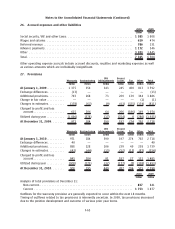 253
253 -
 254
254 -
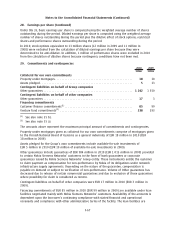 255
255 -
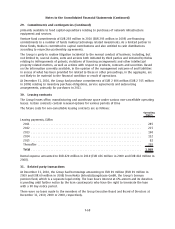 256
256 -
 257
257 -
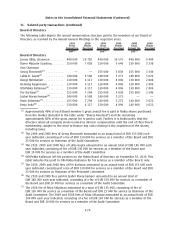 258
258 -
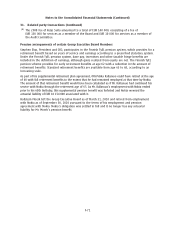 259
259 -
 260
260 -
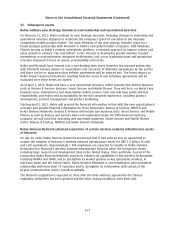 261
261 -
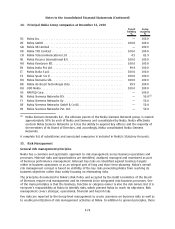 262
262 -
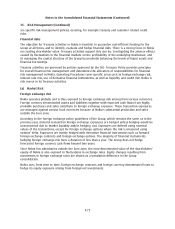 263
263 -
 264
264 -
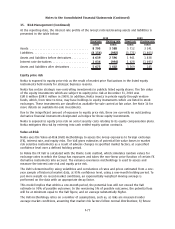 265
265 -
 266
266 -
 267
267 -
 268
268 -
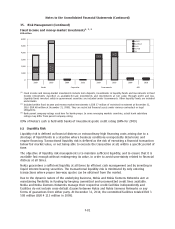 269
269 -
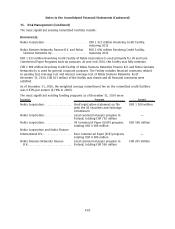 270
270 -
 271
271 -
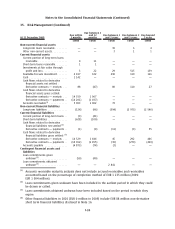 272
272 -
 273
273 -
 274
274 -
 275
275
 |
 |
35. Risk Management (Continued)
are specific risk management policies covering, for example treasury and customer related credit
risks.
Financial risks
The objective for Treasury activities in Nokia is twofold: to guarantee costefficient funding for the
Group at all times, and to identify, evaluate and hedge financial risks. There is a strong focus in Nokia
on creating shareholder value. Treasury activities support this aim by: i) mitigating the adverse effects
caused by fluctuations in the financial markets on the profitability of the underlying businesses; and
ii) managing the capital structure of the Group by prudently balancing the levels of liquid assets and
financial borrowings.
Treasury activities are governed by policies approved by the CEO. Treasury Policy provides principles
for overall financial risk management and determines the allocation of responsibilities for financial
risk management in Nokia. Operating Procedures cover specific areas such as foreign exchange risk,
interest rate risk, use of derivative financial instruments, as well as liquidity and credit risk. Nokia is
risk averse in its Treasury activities.
(a) Market Risk
Foreign exchange risk
Nokia operates globally and is thus exposed to foreign exchange risk arising from various currencies.
Foreign currency denominated assets and liabilities together with expected cash flows from highly
probable purchases and sales contribute to foreign exchange exposure. These transaction exposures
are managed against various local currencies because of Nokia’s substantial production and sales
outside the Euro zone.
According to the foreign exchange policy guidelines of the Group, which remains the same as in the
previous year, material transaction foreign exchange exposures are hedged unless hedging would be
uneconomical due to market liquidity and/or hedging cost. Exposures are defined using nominal
values of the transactions, except for foreign exchange options where the risk is measured using
options’ delta. Exposures are mainly hedged with derivative financial instruments such as forward
foreign exchange contracts and foreign exchange options. The majority of financial instruments
hedging foreign exchange risk have a duration of less than a year. The Group does not hedge
forecasted foreign currency cash flows beyond two years.
Since Nokia has subsidiaries outside the Euro zone, the eurodenominated value of the shareholders’
equity of Nokia is also exposed to fluctuations in exchange rates. Equity changes resulting from
movements in foreign exchange rates are shown as a translation difference in the Group
consolidation.
Nokia uses, from time to time, foreign exchange contracts and foreign currency denominated loans to
hedge its equity exposure arising from foreign net investments.
F75
Notes to the Consolidated Financial Statements (Continued)
